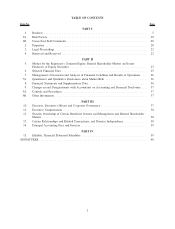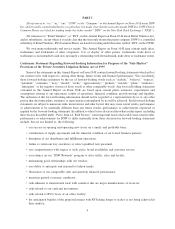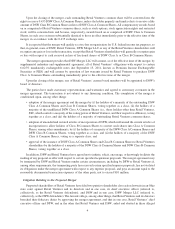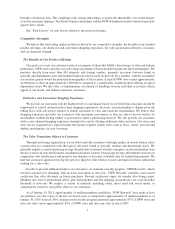DSW 2010 Annual Report Download - page 16
Download and view the complete annual report
Please find page 16 of the 2010 DSW annual report below. You can navigate through the pages in the report by either clicking on the pages listed below, or by using the keyword search tool below to find specific information within the annual report.We rely on our good relationships with vendors to purchase better-branded merchandise at favorable
prices. If these relationships were to be impaired, we may not be able to obtain a sufficient assortment of
merchandise at attractive prices, and we may not be able to respond promptly to changing fashion trends,
either of which could have a material adverse effect on our competitive position, our business and
financial performance.
We do not have long-term supply agreements or exclusive arrangements with any vendors and, therefore, our
success depends on maintaining good relationships with our vendors. Our growth strategy depends to a significant
extent on the willingness and ability of our vendors to supply us with sufficient inventory to stock our stores. If we
fail to maintain our relationships with our existing vendors or to enhance the quality of merchandise they supply us,
and if we cannot maintain or acquire new vendors of in-season better-branded merchandise, our ability to obtain a
sufficient amount and variety of merchandise at favorable prices may be limited, which could have a negative
impact on our competitive position. In addition, our inability to stock our DSW stores with in-season merchandise at
attractive prices could result in lower net sales and decreased customer interest in our stores, which could adversely
affect our financial performance.
During fiscal 2010, merchandise supplied to DSW by three key vendors accounted for approximately 20% of
our net sales. The loss of or a reduction in the amount of merchandise made available to us by any one of these
vendors could have an adverse effect on our business.
We may be unable to anticipate and respond to fashion trends and consumer preferences in the markets
in which we operate, which could have a material adverse effect on our business, financial condition and
results of operations.
Our merchandising strategy is based on identifying each region’s customer base and having the proper mix of
products in each store to attract our target customers in that region. This requires us to anticipate and respond to
numerous and fluctuating variables in fashion trends and other conditions in the markets in which our stores are
situated. A variety of factors will affect our ability to maintain the proper mix of products in each store, including:
variations in local economic conditions, which could affect our customers’ discretionary spending and their price
sensitivity; unanticipated fashion trends; our success in developing and maintaining vendor relationships that
provide us access to in-season merchandise at attractive prices; our success in distributing merchandise to our stores
in an efficient manner; and changes in weather patterns, which in turn affect consumer preferences.
If we are unable to anticipate and fulfill the merchandise needs of each region, we may experience decreases in
our net sales and may be forced to increase markdowns in relation to slow-moving merchandise, either of which
could have a material adverse effect on our business, financial condition and results of operations.
Our operations are affected by seasonal variability.
Our business is subject to seasonal merchandise trends when our customers’ interest in new seasonal styles
increases. Spring styles are new in the first quarter, and fall styles are new in the third quarter. As a result of seasonal
merchandise trends, any factors negatively affecting us during these periods, including adverse weather, the timing
and level of markdowns, fashion trends or unfavorable economic conditions, could have a material adverse effect on
our financial condition, operating cash flow and results of operations for the entire year.
Our sales and quarterly financial performance may fluctuate for a variety of reasons, which could result
in a decline in the price of our Class A Common Shares.
Our business is sensitive to customers’ spending patterns, which in turn are subject to prevailing regional and
national economic conditions and the general level of economic activity. Our comparable store sales and quarterly
results of operations have fluctuated in the past, and we expect them to continue to fluctuate in the future. A variety
of other factors affect our sales and quarterly financial performance, including: challenging U.S. economic
conditions and, in particular, the retail sales environment; changes in our merchandising strategy; timing and
concentration of new DSW store openings and related new store and other start-up costs; levels of new store
expenses associated with new DSW stores; changes in our merchandise mix; changes in and regional variations in
12
























